Lily organized her Halloween candy in this array. What is the multiplication equation for the array?
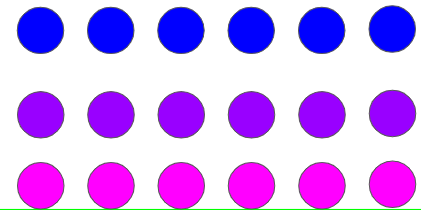
3 x 6 = 18
Which multiplication equation could represent the following repeated addition equation?
3 + 3 + 3 + 3 + 3
A. 3 x 5 = 15
B. 5 x 3 = 15
C. 3 x 3 = 9
D. 12 = 15 x 3
B. 5 x 3 = 15
Cameron wrote to equations on the board. Choose Yes or No to indicate if each equation is true.
1. 7 x 1 = 1
a. Yes
b. No
2. 0 x 4 = 0
a. Yes
b. No
1. No; 7 x 1 = 7
The Identity Property of multiplication tells us that any number multiplied by one equals itself
2. Yes
The Zero Property of multiplication tells us that any number multiplied by zero equals zero.
A dance team has 6 rows of dancers. There are 7 dancers in each row. How many dancers are there in all?
A. 16
B. 27
C. 42
C. 42
A strategy to help me: I know that 5 rows of 7 dancers is 35, so 6 rows of 7 dancers has to be a greater number.
Make an array represented by the following expression AND solve for the product:
4 x 3 = _____
4 x 3 = 12
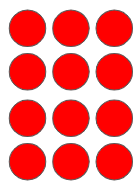
AniyLa drew this model. Choose all the equations that represent her model.

A. 2 x 6
B. 2 + 2 + 2 + 2 + 2 + 2
C. 6 + 6
D. 6 x 2
E. 12 x 1
B. and D.
Choose the expression that has the greatest product.
A. 8 x 0
B. 9 x 1
C. 2 x 4
B. 9 x 1
Rosa bought 3 packs of gum. Each pack has 7 pieces of gum.
Part A: Which picture best represents this situation?
A.

B.
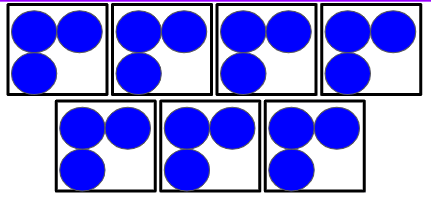
Part B: How many pieces of gum did Rosa buy?
Rosa bought _____ pieces of gum.
Part A. Picture A.
Part B. Rosa bought 21 pieces of gum.
Which of the following choices represents an array that has the factors 3 and 5?
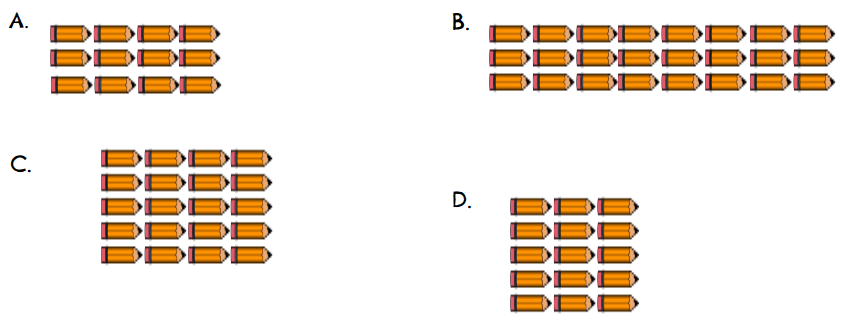
D. The equation is 5 x 3 = 15
Miranda found a dime on the sidewalk every day that she walked home for 4 days. Choose the equations that show a way to find the amount of money that Miranda collected. Be sure to choose all that apply. Reminder: a dime is 10 cents.
A. 10 + 4
B. 4 x 10
C. 4 + 4 + 4 + 4 + 4 + 4
D. 10 + 10 + 10 + 10
B and D.
Four days of 10 cent dimes.
Which expression is equal to 3 x 6?
A. 1
B. 6 x 3
C. 6 x 2
D. 0
B. 6 x 3
The Commutative Property of Multiplication tells us that the order of the factors can change but the product will be the same.
Simone says that the equation 4 x 6 can also be represented by the repeated addition equation
4 + 4 + 4 + 4 + 4 + 4.
Is Simone correct? Why or why not?
No, Simone is not correct because the equation shows that there are 4 sixes, not 6 fours. Simone's equation has the same sum as the product, but it does not represent the same equation. Simone's equation is the same as 6 x 4.
How many rows and columns are in the following array?
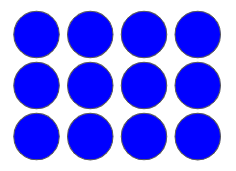
3 rows and 4 columns.
Which multiplication fact does the number line show?
A. 10 + 10 + 10 + 10
B. 2 + 2 + 2 + 2 + 2
C. 5 x 2
D. 2 x 5

C. 5 x 2
There are 5 jumps of 2.
Gavin is thinking of a number that is a multiple of 2. Could 17 be Gavin's number?
Part A. Choose yes or no.
A. Yes
B. No
Part B. Then, explain why or why not.
Yes/No, 17 could/could not be Gavin's number because _____.
Part A. No
Part B. 17 could not be Gavin's number because 17 is not a multiple of 2. All multiples of 2 end in 0, 2, 4, 6, or 8, so there is nothing that multiples by 2 to equal 17.
Uwezo says that an array with 4 rows and 5 columns has 16 items. Is this reasonable? Explain your reasoning.
No, Uwezo's answer is not reasonable because 16 is not a multiple of 5. 4 rows of 5 equals 20, not 16.
Describe how these two arrays are related.
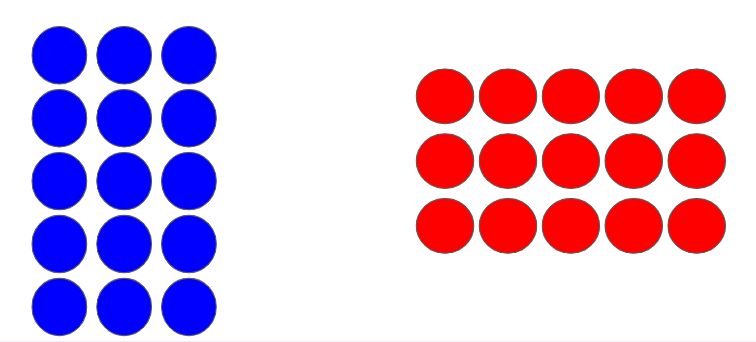
They have the same product and the same factors, but the factors are in a different order.
Both arrays equal 18, but one is 3 rows of 6 and the other is 6 rows of 3.
Martin organizes his Pokemon cards in an album. On one page, he has 5 rows of 3 cards. Martin has 4 pages in his album. How many cards are in his album?
Part A. Which equation represents this story problem?
A. 5 x 3 x 3 B. 5 x 3 x 4 C. 4 x 4 x 5
Part B. Which equation could help you solve this math story?
A. 15 x 3 B. 16 x 4 C. 12 x 5
Part A: B. 5 x 3 x 4 (5 rows x 3 cards x 4 pages)
Part B: 12 x 5 (4 x 3 = 12; 12 x 5)
Eli is thinking of a number that is a multiple of both 2 and 5. Could 20 be Eli's number? Choose yes or no, then explain your answer.
A. Yes
B. No
Yes, 20 could be Eli's number/No, 20 could not be Eli's number because ______.
Yes, 20 could be Eli's number because 20 is equal to 4 x 5 and 10 x 2 so it is multiple of both 5 and 2.
A room had 5 tables. Each table had 3 flower pots on it. Each pot had 2 flowers in it. How many flowers are there in all?
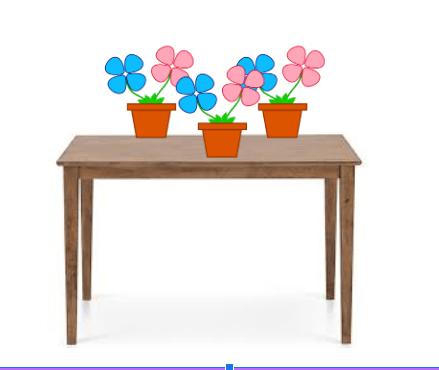
Part A: Draw a model for this problem.
Part B: Use your model to help you solve the total number of flowers.
5 tables x 3 flowers pots x 2 flowers
5 x 3 x 2 OR 3 x 2 x 5
15 x 2 OR 6 x 5
There are 30 flowers in all.